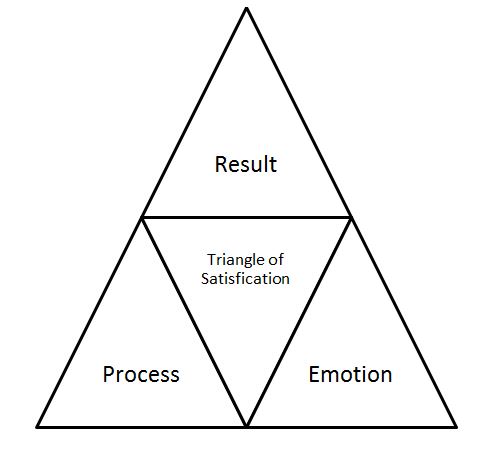In most selling situations, we tend to focus on the greatest competing interest. By doing so we intensify most problems and sometimes we resolve them and sometimes we don’t. Readers of my blog know I like to take a more Appreciative Inquiry approach that SOAR versus SWOT approach (Are you SWOTing or SOARing?). I found the Triangle of Satisfaction as a unique method for using an Appreciative Inquiry or Strength-Based approach. I was introduced to this concept in the book,The Conflict Resolution Toolbox: Models and Maps for Analyzing, Diagnosing, and Resolving Conflict.
The Triangle of Satisfaction as you would presume says that there are three areas of interest that we must address. Each interest requires a different approach and involvement to resolve any issues. The three interests are Result, Process and Emotion.
Definitions from the Book:
- The Result is the what, the outcome or the most tangible part of the conflict.
- The Process is the how the process by which we reach a result. When the solution is implemented, how fair the process is, how inclusive the process is, how transparent the process is, who is involved in the negotiation or decision-making process, are all process of procedural interest.
- The Emotion is what is going on emotionally or psychologically as we try to reach an agreement. Wanting to win, to save face, wanting to be heard, issues of status or self-worth, quality of the relationship, wanting an apology or wanting revenge, feeling satisfied – these are all psychological or emotional interest parties may have.
 The triangle is used to identify which interest is the most important at any given time. These interests and the drivers within each interest changes throughout any given process. Using this format, we can see what is motivating someone and from an appreciative standpoint and see where common interest lie.
The triangle is used to identify which interest is the most important at any given time. These interests and the drivers within each interest changes throughout any given process. Using this format, we can see what is motivating someone and from an appreciative standpoint and see where common interest lie.
The book sets forth three strategies to be utilized based on Triangle of Satisfaction.
Strategy #1, Focus on Common Interest: If we dig deep enough, we typically can find a common interest. It may not surface as one of the larger three interests; it may be only a portion of one. The point is to find one and start building a relationship from that point that common thread.
Strategy #2, Work with Each Type of Interest Differently:
- Results interests are tangible issues that can be negotiated, bargained or compromised towards a solution.
- Process Interests tend not to be completely solved but negotiated through a change process.
- Emotional Interests are seldom solved and must be addressed diplomatically and treated as importantly as others.
Strategy 3#, Move around the Triangle to Avoid Gridlock: Gridlock often happens because we get stuck on a central issue that stops us from continuing. Solving gridlock often happens when we are working on other issues versus the one that is gridlocked.
A few examples paraphrased from the book that helps us move around the triangle:
Lead with Process when gridlocked on Results: Agree to a process (Arbitration) that you will accept the solution (Result).
Result or Process when gridlocked on Emotion: Independent verification or joint ownership of the process at beginning of engagement may overcome low-trust (Emotion).
Emotion when gridlocked on Result or Process: Acknowledgement of each other issues, not agreement in a genuine fashion may lead to more flexibility in the process and the results.
Process when gridlocked on Emotion: A third party intervention is often needed or even the meeting of different departments that want this matter resolved.
Continually working around the triangle is a simple and an effective tool in sales and marketing. Continually working around the triangle as common interest surfaces increases buy-in. That Appreciative take on things. Seldom will all three interests not surface during a sales process and, as a result, will need to be addressed. Remember, this is only the surface of the discussion. You should list each parties interest, there may be several in each and multiple people, as you see them develop including your own. Your own biases may be more important to recognize than the prospects.

Comments are closed.